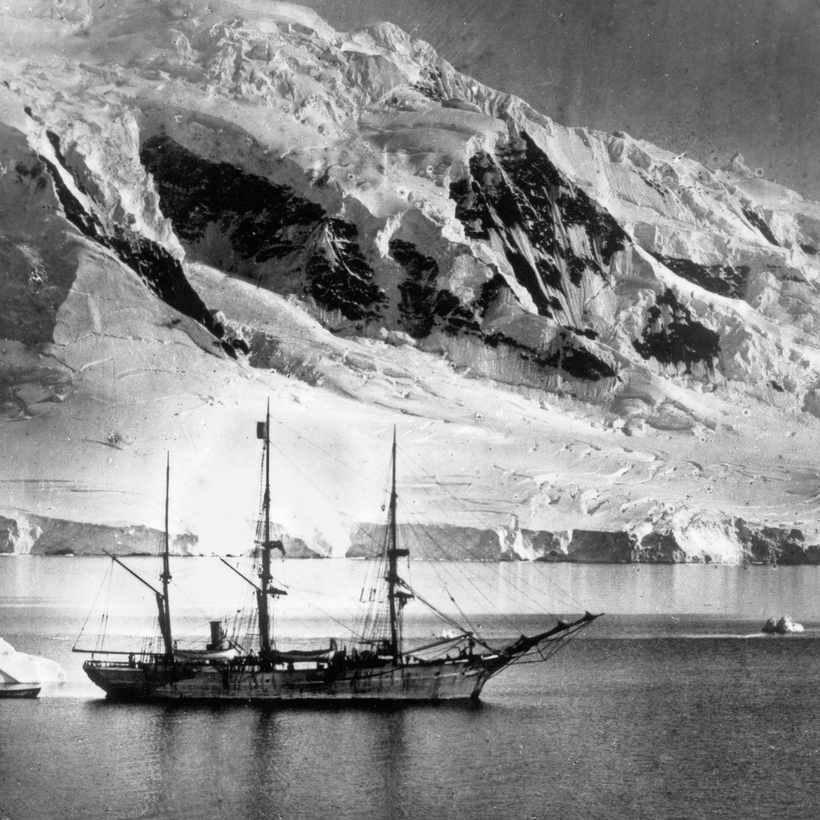Tales of Antarctic expeditions from the Heroic Age at the turn of the last century vie with one another in the depths of the misery they explore. The doomed wooden ships have names like Impetuous, Obstinate, Delirious. Accounts of their last moments are written on the backs of labels for Mrs. Potter’s Tinned Yorkshire Peas.
Back home—fingers missing, noses shortened—survivors trade stories for drink, fixing strangers with a remaining eye: It were the sled dogs saved us, I won’t lie to you. A fine stew they made. Apsley Cherry-Garrard described his expedition to retrieve an unhatched emperor-penguin egg as “the worst journey in the world”—the title of his classic account. The cold made his teeth chatter so violently that he broke them all.

But before Cherry-Garrard—and before Roald Amundsen and Robert Falcon Scott’s fateful race for the South Pole—there was the ill-fated Belgica expedition, the subject of Julian Sancton’s enthralling and beautifully written Madhouse at the End of the Earth.
Out in the Cold
The Belgica left Antwerp in 1897 under the command of Adrien de Gerlache, an erratic and entitled enthusiast from a prominent Belgian family. As a boy, de Gerlache had once spent months building a model of a sailing ship, only to see it carried over a waterfall in a stream on its maiden voyage. Sancton writes, “The Cambrier, as he’d christened her, was the first ship under his command, and his first shipwreck.”
But he loved the sea and he relished tales of polar exploration. With a complement of scientists and a fractious international crew, the Belgica reached Antarctica as summer in the southern hemisphere was receding. De Gerlache sailed deep into the pack ice anyway. He was unable to escape before winter set in, bringing three months of darkness and locking the ship in the ice.
What happened next forms the heart of the book. No human being had wintered in Antarctica before. The crew of 17 was soon bunk-ridden, with scurvy from poor nutrition and lack of sun. Despondency and depression gave way to something worse. Men heard voices, became suicidal. “We are in a mad-house,” one of the scientists wrote in his journal. De Gerlache himself was incapacitated.

The heroes proved to be the ship’s American surgeon, Frederick Albert Cook, and the indestructible Norwegian first mate, Roald Amundsen. Cook forced the crew to eat as much fresh meat as the men could obtain, which meant mostly penguin and sometimes seal. We now know, but Cook didn’t, that fresh meat provided the vitamin C that the men were missing. The rarer the better:
Without hesitation, Amundsen dropped to his knees, slashed his knife across the animal, lay down alongside the carcass, and placed his mouth against the laceration, sucking warm blood from the wound. Even though the seal had been killed hours earlier and left on the ice, its thick coating of blubber had kept its insides from cooling down. Once he had drunk his fill, he offered his place to Cook.
Fitfully, the crew began to recover. But would the ice release its grip? The Belgica remained stuck even when summer returned. In desperation, the crew used ice saws to cut a mile-long channel to open water—working around the clock for weeks, under a never-setting sun—only to see the ice sheets on either side, two meters thick, come together one night and slam the channel shut.
Then, miraculously, wind and water created a momentary new fissure. Explosives dislodged the ice around the ship. The Belgica was free.

Sancton can reconstruct the Belgica’s story in detail because the principals kept diaries. Though confined to the ship, they also wrote letters to one another; nerves and personal relations were so frayed that spoken words led to violent arguments. And there are photographs. Cook had a camera and took pictures of the ship and its men, as well as the first ones ever of Antarctica. Sancton adds vivid touches—describing, for instance, how a crew member once caught an albatross, casting a baited hook into the air with a fishing rod.
No human being had wintered in Antarctica before. Despondency and depression gave way to something worse. “We are in a mad-house,” one crew member wrote in his journal.
The bond between Cook and Amundsen was enduring. Amundsen would become the first man to reach the South Pole. Cook would claim to be the first to reach the North Pole—a declaration that made headlines before being discredited. Cook turned himself into a lecturer and showman, then into a Ponzi-scheme huckster who ran afoul of federal statutes. Amundsen visited him in prison at Fort Leavenworth.
The same 12 actors keep showing up in every British television drama. Madhouse at the End of the Earth, too, gives us all the familiar polar figures—Amundsen, Scott, Peary, Nansen, Shackleton, Franklin—against a backdrop of icy rigging and groaning timbers. Think of it as Masterandcommanderpiece Theater. For anyone in the throes of pandemic self-pity, this book will provide perspective, perhaps even serve as a restorative. Like a penguin.
Cullen Murphy is the editor at large of The Atlantic and the author of several books, including God’s Jury: The Inquisition and the Making of the Modern World and Are We Rome? The Fall of an Empire and the Fate of America

